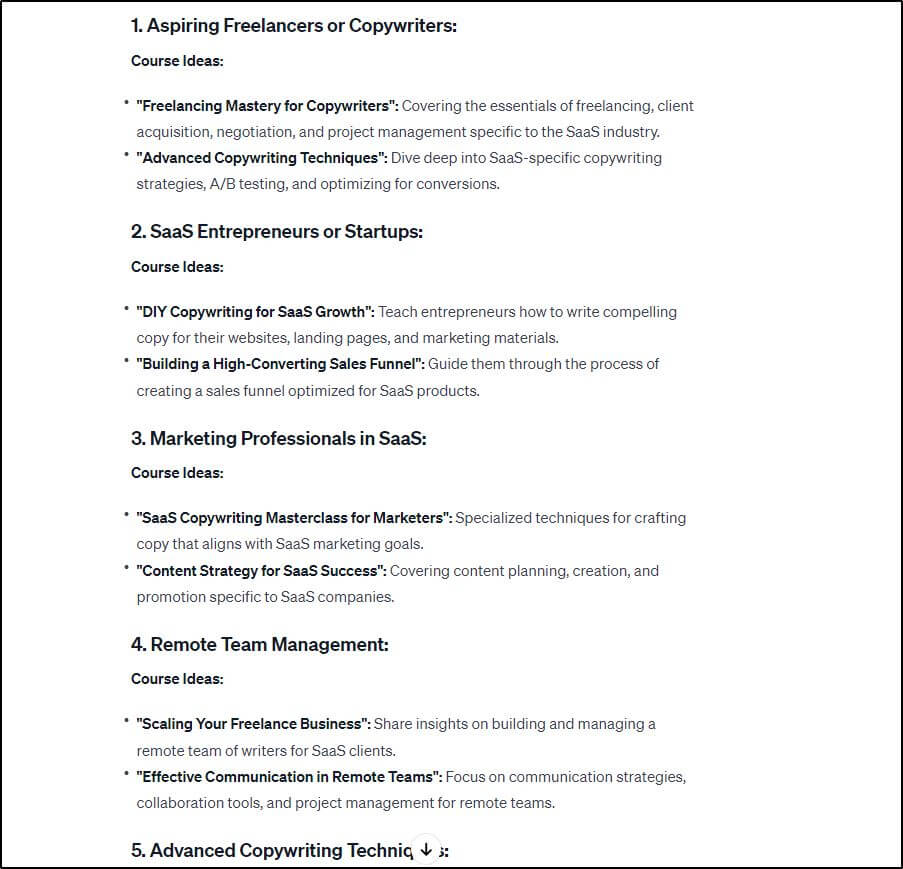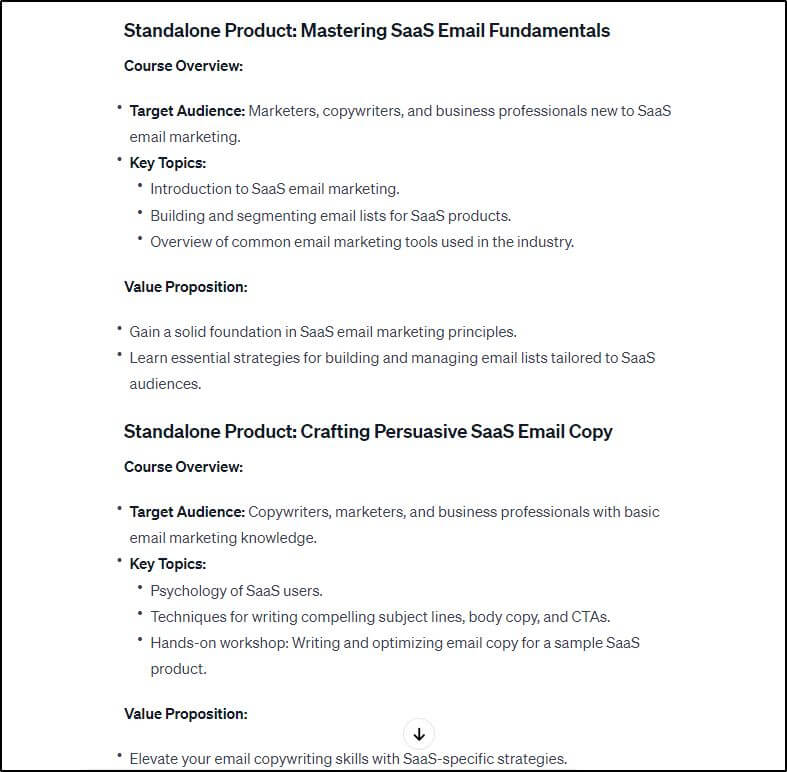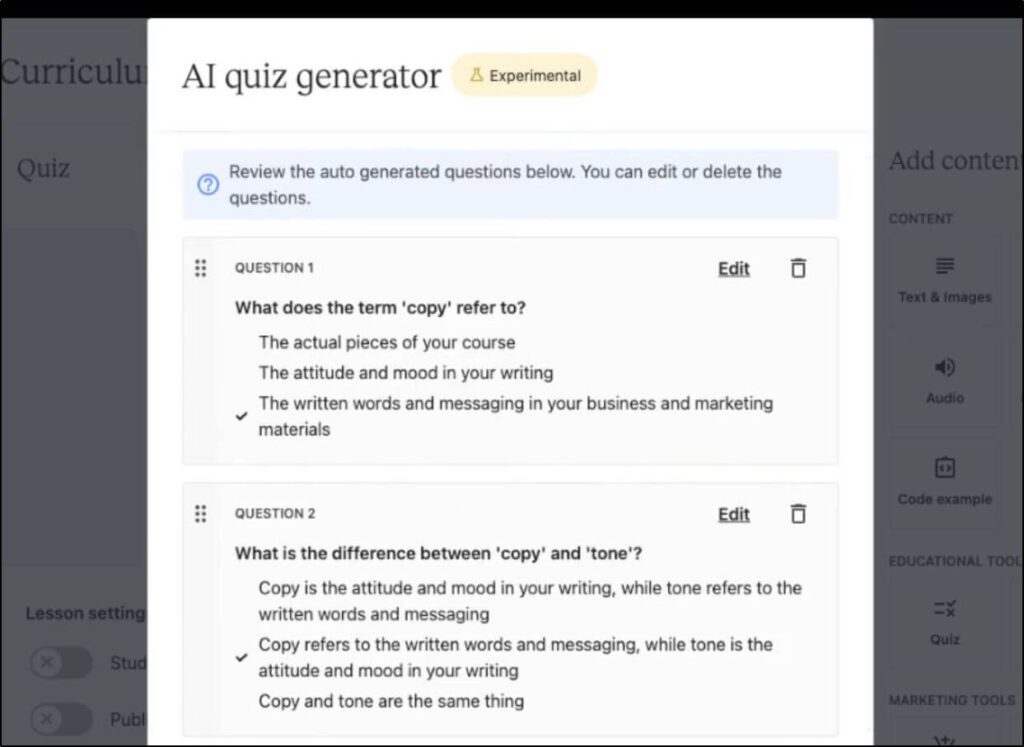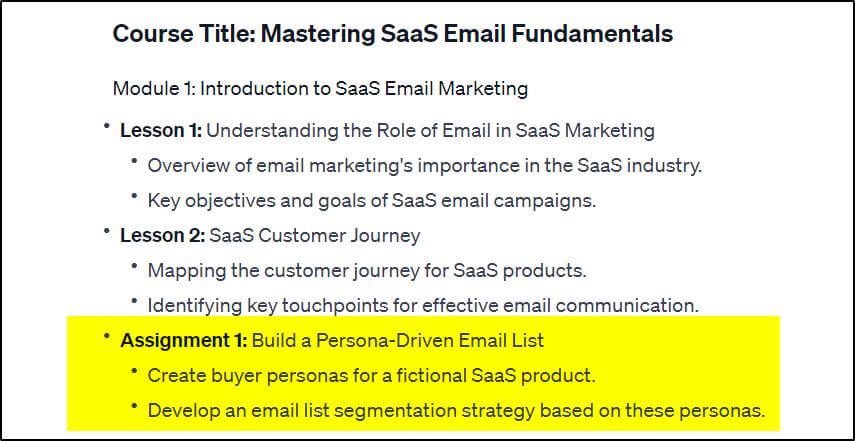

Many course creators fear people will stop buying their programs because ChatGPT, Bard, and other generative AI tools can answer every question for free.
But our experience of over two decades in the e-learning industry says that isn’t happening any time soon.
Why? Because people want to learn from experts with real-world experiences, not just theoretical knowledge. They crave authentic connections and a human touch in learning.
However, generative AI tools can help you simplify some of the most time-consuming and complex parts of creating courses, memberships, and other digital products (only if you know how to use them.)
In this article, we’ll share different generative AI use cases with examples to show how you can leverage this revolutionary technology to create better learning experiences and grow your business faster.
Let’s dive in.
Gen AI Use Cases For Course Creators: How To Create AI-Powered eLearning Programs
A recent study by Statista found that 38% of people who use generative AI tools do it for fun without any apparent business strategy. Another 34% use it for faster searches.
So, you’re already ahead of most of them if you’re considering ways to profit from this technology.
For this article, we’ll focus on use cases that directly impact the content of your digital products, your customers’ learning experience, and your course marketing strategy.
Why? Several recent surveys indicate these are the areas most course creators find challenging.
Gen AI Use Case #1: Find Online Course Ideas
Staring at a blank screen for hours, not knowing what to write.
Every creative professional knows that feeling – and hates it.
This is why idea generation is among the most popular AI use cases for bloggers, writers, and course creators.
Generative AI tools can help you overcome your creative block by listing ideas for any content you want to create.
For example, if you’re looking for online course ideas, just tell ChatGPT about your expertise, experience, and the audience you want to serve.
Just like this.


It instantly generated a long list of course ideas we can refine and use for different audiences.


You can also use Kajabi’s AI tools to generate ideas because they are explicitly designed for eLearning professionals.
But beyond idea generation, you can build complete learning tracks for your students, offering a roadmap for product creation.
For example, you can ask Bard or ChatGPT to create a series of course ideas to help your students reach a specific learning goal. It can start from an entry-level course, followed by intermediate and advanced courses.
This helps you break down your knowledge into consumable chunks, increases your product range, and allows you to target specific audiences.
For example, here are the courses ChatGPT suggests we should create to help learners become expert SaaS copywriters.


And finally, you can use ChatGPT to package your knowledge and course content more effectively.
For example, it can help you organize your thoughts and group different topics to create course modules and lessons.
You can do all of those things manually as well.
However, using ChatGPT accelerates the process and allows you to invest your energies into the more creative parts of the course creation process.
Gen AI Use Case #2: Personalize Student Learning Tracks
Whether you run cohort courses or sell memberships and pre-recorded lectures, every participant in your e-learning programs has unique strengths and weaknesses.
Making them follow the same learning path doesn’t make sense.
Before AI, we didn’t have a choice.
But thanks to generative AI tools and advanced learning platforms, you can tailor your content to the course participant’s needs.
Instead of offering everyone the same learning path, AI analyzes student performance and interests and suggests content that helps them overcome their weaknesses.
For example, Cerego is an adaptive learning platform that tracks student performance, identifies weaknesses, and serves tailored content to help them progress.
This ensures no student is left behind, and your content makes a difference. Platforms like edX, Khan Academy, and Udacity also use AI-powered adaptive learning techniques. Individual course platforms like Thinkific, Teachable, and others should soon follow suit.
Until then, you can apply this personalization through AI-powered email marketing, creating automated sequences that help students who struggle in a module or seek help in a specific topic.
Gen AI Use Case #3: Design Quizzes And Assignments
Quizzes and assignments make your courses more engaging and help your participants grasp the core concepts of your program.
Ideally, every course module should have at least one quiz or assignment.
But designing effective, engaging quizzes that ask the right questions and test your participant’s knowledge can be tricky.
If they are too hard, the participants might lose motivation. But if you make it too easy, users won’t find them interesting or worth their time.
AI chatbots can be the perfect tools to find engaging quiz and assignment ideas. For example, Teachable has a robust AI Quiz generator that studies the content of a specific module in your course and generates a detailed quiz for your students.


It saves you a ton of time by designing quizzes that test your students for the core concepts of your course module.
You can edit and add/remove questions or change your quiz type depending on your assessment goals.
Similarly, we asked ChatGPT to generate a course outline and suggest assignments and quizzes for each module. Here’s what we got.


If you don’t like its ideas, try different prompts or provide more context about your course and the things you want to assess in your students.
But, in our experience, its ideas are spot on.
Gen AI Use Case #4: Offer Meaningful Feedback
If you want your course participants to consume your knowledge and progress toward their goals, you must provide them with helpful, actionable, and meaningful feedback.
However, sharing feedback individually with every participant can be time-consuming, especially if you run large cohorts.
Once again, generative AI can be a lifesaver.
Here’s how to do it.
Feed your assessment criteria to ChatGPT or Bard, and describe the goals you want your participants to achieve through your assignments or quizzes.
For example, if you’re running a copywriting course, you could say
“I want them to use action words in their CTAs and create urgency in a positive tone. Here are examples of CTAs I consider as benchmarks. Example 1, Example 2, Example 3, Example 4, Example 5. I will now submit my students’ assignments and want you to grade them out of 10, provide feedback on writing style and grammar, offer suggestions for improvement, and identify areas where students struggle.
AI’s feedback won’t be perfect, and you’ll need to chime in with your expertise and perspective. But it will accelerate your feedback process by creating an initial draft based on your prompts.
Gen AI Use Case #5: Make Your Course Accessible
You want your course to benefit as many people as possible, irrespective of their abilities or physical disabilities. While it’s difficult to create one perfect course that caters to all of them, AI can make your course content more accessible and help you reach a wider audience.
For example, here are several ways AI can make your course more inclusive and accessible.
- Publishing transcripts of your videos and audio for people with hearing problems
- Generating closed captions for videos
- Using alt text and descriptions for images
- Using a large font and easy-to-read font
Online course platforms like Teachable, Kajabi, and Thikific have built-in accessibility features. Similarly, tools like Pictory and Descript can also make your course content more accessible and ensure inclusiveness. However, you can use free tools like ChatGPT or Bard as well.
Gen AI Use Case #6: Develop Multilingual Courses
Want to dodge competition and expand your customer base? Design multilingual courses.
Thanks to AI, you can do that without being an expert in other languages.
Tools like Pictory, Wondercraft AI, and Speechlo help you automatically translate and dub your content in numerous languages.
For example, if your lectures are in English, Wondercraft AI will translate and dub them into Spanish or any other popular language you want. Using the dubbed audio, you can generate AI videos with closed captions and transcripts.
Making your course multilingual is even easier if you have text-only content.
Just copy/paste everything into Google Bard or ChatGPT and generate the translated version of your content.
However, we always recommend proofreading and editing AI-generated content because it usually has inaccuracies.
Overall, it will help you create a usable multilingual version of your course that you can use to expand your business to international markets.
Gen AI Use Case #7: Design Interactive Learning Activities
Want your course participants to fully grasp and implement your teachings? Then, add interactive learning activities to your course that allow participants to practice your content in various scenarios.
Beyond assignments and quizzes, interactive activities can boost your course completion rates and foster more success stories among your students.
For instance, if you’re running a copywriting course or membership community, you can create teams among your members and challenge them to tackle real-world client problems or scenarios.
Similarly, you could run role-playing exercises where you become the client, and your course participants act as copywriters. Ask them to run a mock discovery or project kick-off call to see how much they’ve learned from your content.
With AI, you can find numerous ideas for designing engaging and interactive learning activities for your courses. It can suggest a gamified learning approach by understanding your course content and your goals for your students.
These team-based exercises encourage collaboration, problem-solving, and the application of learned concepts in a practical setting.
Gen AI Use Case #8: Generate Images And Visuals
Your online course should ideally be a combination of text and audio/video lessons. However, if you have a text-only course or run a closed community where you post long threads, add relevant and engaging visuals to the mix to enhance the learning experience.
We’re not talking about stock photos here.
Instead, use visuals like infographics, charts, graphs, or anything that adds value to the learning experience.
Tools like Piktochart and Venngage are AI-powered infographic generators that use your prompts and image description to create engaging graphs and infographics.
Similarly, you could use an AI image generator like Canva, Midjourney, or NightCafe to create stunningly realistic visuals that complement your text content.
Recently, we’ve seen a trend among creators to use their AI avatars in their interactions with course participants and community members.
It may not directly contribute to the course content, but it certainly adds a layer of enjoyment and engagement to the overall learning experience.
Gen AI Use Case #9: Grow Your Influence With Podcasts
If you want to sell high-ticket courses or attract consultancy clients, establish authority in your niche and position yourself as an expert.
And there’s no better way to do that than publishing high-quality podcasts where you demonstrate your knowledge, answer your audience’s questions, and resolve their problems.
But podcasting requires long-term commitment and a lot of resources upfront. And it can be daunting for a solopreneur or someone juggling a dozen business roles.
This is why using AI podcasting tools like Wondercraft AI or Descript can be a game-changer.
With AI podcasting, you can generate podcast scripts, replicate your voice, and create studio-quality podcasts without investing in expensive equipment.
They reduce your podcast production times from several hours to just a few, saving you time and resources.
If you already have a podcast recording, AI tools can generate transcripts, help repurpose your podcast in multiple formats, and increase your content’s exposure without additional effort.
For example, you can use Wondercraft to turn your podcast audio into a video for YouTube, Facebook, or other platforms. Similarly, you can generate audiograms and short clips for TikTok or Instagram Reels.
AI podcasting tools even empower you to start faceless YouTube channels and dedicated podcasts in AI voices. So, if you prefer staying behind the scenes or want to experiment with podcasting or YouTube without putting your brand image on the line, AI podcasting tools are made for you.
Gen AI Use Case #10: Build Authority With YouTube Videos
Like podcasting, covering the core topics of your niche in YouTube videos is another proven way to establish authority.
We’ve already discussed faceless YouTube channels that come in handy if you don’t want to show your face or risk your brand image.
But you’ll need to face the camera to build a personal brand that attracts customers for your coaching business, membership groups, or online courses.
AI can make this process much more affordable and convenient.
For example, you can use Adobe Premiere Pro to create AI-powered virtual backgrounds that look stunningly realistic.
Similarly, you can use AI tools to find compelling video ideas, generate scripts, captions, and transcripts, and optimize your video titles and descriptions for greater exposure.
You can also copy the comments on your YouTube videos and ask ChatGPT or Bard to find recurring questions or generate ideas based on viewer feedback.
Doing all those things manually takes hours. With AI, it’s a matter of minutes.
Gen AI Use Case #11: Get Traffic With SEO Content And Social Media
As an eLearning professional, you know that creating a digital product is only half the job. To attract leads and drive sales, you must grow your influence and generate traffic to your website and landing pages from search engines and social media platforms.
For that to happen, you must create a ton of unique and valuable content and optimize it for the right keywords. To build social influence, you need to consistently publish problem-solving content on Twitter, Facebook, LinkedIn, or any other platforms your audience uses.
But content creation can be mentally draining because it requires a lot of research, hard work, and time.
AI content writing tools like JasperAI, Koala, and ChatGPT can simplify this part to a great extent.
Instead of researching unique content ideas for hours, use AI tools to develop your complete content calendar for a quarter. Then, use the same tools to generate article outlines and first drafts.
Now, you only need to edit the content, add your personal experience, include a few examples, and optimize the content for SEO.
Similarly, you can generate your whole month’s worth of social media content in just a few hours using AI tools like Thinkific’s Social Media Post Generator.
Buffer, a leading social media scheduling app, launched an AI assistant that helps users generate ideas and content for different social networks. It also lets you schedule your posts by identifying your audience’s active hours. This ensures that your content gets the maximum eyeballs, giving you a better chance to drive traffic to your site.
Gen AI Use Case #12: Create Your Course Website And Landing Pages
As a creator, you must have a professional website that positions you as an expert and acts as the center of all your marketing activities.
This is where you’ll tell the world about yourself, publish authoritative content, and drive traffic from search engines and social media.
Using AI tools like 10Web, you can generate a professionally designed website within minutes. It only asks a few questions about yourself, your audience, and your core offer and then uses AI to generate an editable design.
You only need to customize it using a website editor, replace the dummy content, and add your images to make the site publicly available.
It can also replicate your competitors’ landing page designs, allowing you to quickly set up lead generation and marketing campaigns.
In short, AI technology has dramatically simplified website and landing page creation. So, if you’ve been putting your new site on the back burner for a while, now’s the time to change things for the better.
Gen AI Use Case #13: Design Unique Lead Magnets
If you want to future proof your eLearning business, grow a loyal tribe around your brand. And the best way to do that is by building an engaged email list.
However, you’ll need a compelling lead magnet to convince your website visitors and social media followers to join your list.
Again, AI is there to make your job easier.
Instead of wasting hours looking for lead magnet ideas, tell ChatGPT or Bard about your website’s core purpose, your expertise, and your audience’s main interests. Based on your input, these AI tools will generate dozens of actionable lead magnet ideas that you can immediately use to build your email list.
But don’t stop there.
Once a subscriber joins your list, you’ll need to use automated email sequences to nurture your relationship, provide free value, and move subscribers close to buying your product.
AI can help you design your marketing and sales funnels and share detailed email marketing ideas to engage your subscribers and turn them into customers.
How Are You Leveraging Generative AI In Your Business?
AI’s influence will only increase with time in all industries, including eLearning. However, as new technology emerges, you can find innovative ways to leverage AI tools to accelerate your audience growth and increase course sales.
These generative AI use cases we shared in this article give you a glimpse of what’s possible with this technology. So, don’t get left behind and embrace this generational shift in our industry.



